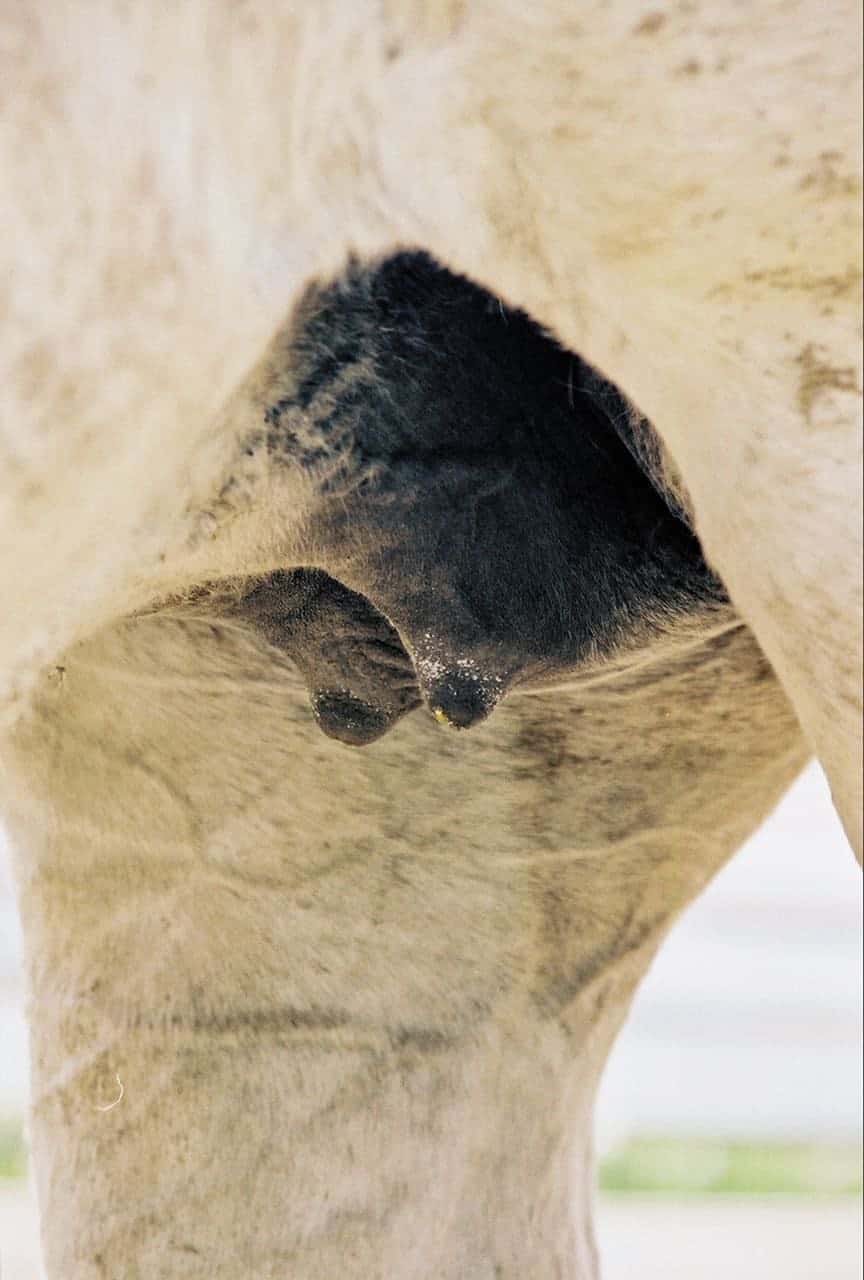Before Your Mare Foals

Critical steps to take and signs to watch for in your broodmare’s third trimester
Few things bring breeders more joy and satisfaction than welcoming their long-awaited foals. But those in the breeding industry know arriving at this milestone is no small feat. Bringing a horse into the world involves thoughtful matching of sire and dam, months of careful preparation, and a major financial investment. So whether you are a first-time breeder or a seasoned breeding farm manager, you want
everything to go well. Here are some tips to help your mare’s third trimester run smoothly.
Changes That Occur During the Third Trimester
The average equine gestation lasts about 320 to 360 days, depending on the mare; each has her own gestational length, and the day she foals is often repeatable from year to year. The final 100 days of gestation (third trimester), however, bring their own unique developments, changes, and challenges. At this stage the placenta is fully developed and produces progestins, including the hormone progesterone, that help maintain the pregnancy to term. The fetus, enveloped by the amnion, grows exponentially. In fact, most of the growth occurs during that last trimester—the foal is only about the size of a house cat (8-15 pounds) at six months but weighs upward of 100 pounds at birth.
The Mare’s General Health Is Key
Nutrition
The pregnant mare’s overall health—the foundation of which is nutrition—is crucial to her in-utero offspring’s development. A broodmare’s ideal body condition score on the 1-to-9 Henneke scale (TheHorse.com/137703) is around a 6. During the third trimester the mare’s overall nutrient requirements increase as her body delivers a significant portion of the nutrition she consumes to the growing fetus via the umbilical cord. She’s eating for two! This applies to not only energy intake (calories) but also amino acids (the building blocks of protein), fat, vitamins, and minerals (notably calcium) needed for proper cartilage, bone, muscle, and other tissue development. The mare also prepares “for lactation in the third trimester. Lactation is the most nutritionally demanding time for a pregnant mare, so having good body condition is especially important at the time of foaling.

That being said, each individual mare’s needs vary, and you must take care not to overfeed her. Feeding excessive nonstructural carbohydrates (mainly starch and sugar) to any horse can potentially lead to metabolic disturbances, infertility, colic, and the debilitating hoof disease laminitis. Additionally, obese mares might have difficulty foaling due to their lack of fitness. Work with your veterinarian and/ or equine nutritionist to develop an individualized feeding plan for every mare at every stage of pregnancy.
Vaccines and biosecurity
Immunization is another essential aspect of general horse health. Unlike in humans and some other species, the thick, multilayered equine placenta prevents disease-fighting antibodies from permeating it and reaching the fetus. The newborn therefore relies on ingesting high-quality colostrum (the mare’s first milk) within the first six to eight hours of life to receive these precious antibodies via passive transfer. While vaccines administered to the dam don’t immunize the foal directly, they protect the mare herself and ensure that her colostrum contains all the necessary immunoglobulins (antibody types) to protect her offspring after ingestion.
You can find full vaccination guidelines for broodmares on the American Association of Equine Practitioners (AAEP) website, but the main take-home point is this: Your pregnant mare must receive the core vaccines: tetanus, rabies, Eastern/Western equine encephalomyelitis (EEE/ WEE), and West Nile virus. Your veterinarian might recommend additional specific risk-based vaccines such as those against botulism, influenza, leptospirosis, rotavirus, Potomac horse fever, and strangles, depending on your region and the equine population at your barn. Vaccination against equine herpesvirus is always necessary and of particular importance because an abortive strain of EHV-1 poses a very real threat to in-utero foals. Veterinarians vaccinate pregnant mares against EHV-1 at five, seven, and nine months of gestation. They generally administer other vaccines four to six weeks before the mare’s due date to maximize colostrum antibody concentration and enhance the newborn’s protection.
It is also important to supplement a vaccination program with biosecurity measures to reduce the chance of transmissible diseases interfering with—or even terminating—the pregnancy. Segregate broodmares from frequent travelers, for instance, and group them by gestational stage. Move them to their foaling location—be that a particular paddock or barn or another farm—four to six weeks before their expected due dates so they can produce antibodies in their colostrum specific to that area.
General preventive care
A pregnant mare has the same preventive and routine health care needs as any other adult horse. While your heavy, balloon-shaped broodmare might not be in work or even in shoes, regular hoof care is, of course, still necessary. Routine deworming during gestation reduces the newborn’s exposure to parasites. Deworm your mare approximately one month prior to her anticipated due date; otherwise, certain parasite larvae could travel through her udder and be ingested by the nursing foal, causing enteritis (inflammation of the small intestine) and diarrhea. Given the importance of correct nutrition in late-term pregnancy, dental health is as instrumental as ever in ensuring the mare is eating efficiently and painlessly, which also helps prevent choke and colic.
“However, it is best to perform any dentistry work after the mare has foaled, since there is potential to shower bacteria from the mare’s mouth to the placenta and developing fetus,” via the bloodstream, says Karen Wolfsdorf, DVM, Dipl. ACT, theriogenologist at Hagyard Equine Medical Institute, in Lexington, Kentucky.
Preventing Abortion
Two of the greatest challenges during the third trimester are keeping the foal healthy and allowing it to grow normally, says Wolfsdorf.
“Achieving this is dependent on two key elements: making sure that the mare doesn’t develop placentitis (inflammation of the placenta) or any contagious disease and ensuring the uterus’ ability to function properly and to provide the appropriate nutrients and oxygen to the developing foal,” she explains.
While many conditions can cause late-term losses in broodmares, placentitis accounts for more than 60% of them, causing abortion, stillbirth, and neonatal death within 24 hours of birth, Igor Canisso, DVM, Dipl. ACT, of the University of Illinois, Urbana, reported in his 2015 AAEP Convention presentation. Most commonly, opportunistic bacteria from the environment travel through the cervix into the mare’s uterus to infect and damage the placenta. This is known as ascending placentitis. Vulvar discharge and premature udder development can be early indicators of placentitis.
“If a mare is high-risk, valuable, or of any concern, she can start being monitored (via transrectal ultrasound) at six months of gestation for any signs of placentitis or abnormalities,” Wolfsdorf says. “That monitoring continues monthly until foaling.”
Dr. Karen Wolfsdorf
Systemic (bodywide) infectious diseases such as EHV-1, as noted, and leptospirosis also have abortive potential. Mares most commonly contract the zoonotic (can spread between animals and humans) disease leptospirosis by ingesting stagnant water contaminated by wildlife urine. Even beyond causing late-term losses, this disease affects several organs and body systems, causing uveitis (moon blindness) and kidney and liver damage.
Another disease that affects pregnant mares is tall fescue toxicosis. While it’s important that your broodmare gets plenty of exercise and grass on turnout, you should remove late-term (upward of nine months) pregnant mares from pastures containing tall fescue grass species. Tall fescue can contain a fungal endophyte called Neotyphodium coenophialum that produces a toxin that once ingested tampers with the mare’s reproductive hormones. This hormonal imbalance can prolong the pregnancy, complicate the parturition (birthing) process by causing premature placental separation (“red bag delivery”), and diminish the mare’s milk supply. If you can’t prevent your mare from consuming endophyte-infected tall fescue, Wolfsdorf recommends medicating with domperidone, a dopamine antagonist that helps counteract the toxin’s damage with a 95% efficacy rate. The mare must receive the drug for at least a month prior to foaling and under a veterinarian’s direction because of its potential side effects, such as premature lactation and failure of passive transfer.
Rana Bozorgmanesh, BVetMed, Dipl. ACVIM, is an internal medicine specialist at Hagyard’s McGee Medicine Center, which houses one of the nation’s largest neonatal intensive care units. Bozorgmanesh and Wolfsdorf strongly recommend testing mares for neonatal isoerythrolysis (NI) about two weeks prepartum. This standard procedure consists of drawing maternal blood and checking for the presence of antibodies that will attack and lyse (destroy) the foal’s red blood cells once he consumes his dam’s colostrum.
“The condition is often life-threatening without early and appropriate intervention,” Bozorgmanesh warns, “and these cases can be very challenging and costly to treat.”
If the mare tests positive, muzzle the foal and administer replacement colostrum immediately after birth. After you’ve collected and discarded the mare’s colostrum, the foal can nurse. Bozorgmanesh has noticed a reduction in NI cases at Hagyard in recent years, as testing has become increasingly common. Because prevention is key, she urges all breeders to perform NI screening if it’s available.
Aside from avoiding diseases and environmental contaminants, what else can owners or managers do to prevent abortion? Progesterone, a hormone administered to “quiet down” the uterus in the face of inflammation, can be effective in individual cases, but its late-term use is controversial, Wolfsdorf says.
“There is some evidence that it may affect the immune system,” she explains. “In my practice, some older mares and those that have placentitis or have lost pregnancies in the past may be candidates for progesterone supplementation. Anti-inflammatory agents and drugs that encourage blood flow to the uterus can also help, depending on the underlying problem. Medication is dependent on the individual situation, and it’s therefore important to discuss any drugs used during pregnancy with your veterinarian.”

Preparing for Foaling
If a mare has had a Caslick’s procedure to seal the upper part of the vulva to outside contaminants that could cause abortion, it’s important to have the veterinarian reopen the vulva before birth so the foal doesn’t tear the area on its way out. To err on the side of caution, vets generally remove these sutures around two weeks before the expected due date.
Most foals are born during the quiet of the night, so breeders often attach signaling devices to the mare’s halter or vulva that detect recumbency (lying down), restless activity, or parting of the vulvar lips and send an alert to the caretaker.
“However, the gold standard remains an experienced and skilled foal-watch person able to identify early signs of impending parturition and associated issues,” says Bozorgmanesh.
Regardless of your chosen method of foal watch, monitoring the mare for signs of impending parturition is crucial. “Know the breeding date (and, thus, the predicted foaling date; TheHorse.com/gestationcalculator), and monitor your mare for mammary gland development,” says Wolfsdorf. “Note whether it is normal (two to four weeks before parturition), premature, or absent.”
Four to six days before foaling, the teats become engorged. Waxing with colostrum usually indicates the foal is one to four days away. The mare’s croup and vulvar muscles also relax at this stage. If you choose to have your mare foal in a barn, set up a spacious (14-by-14-foot or larger) stall deeply bedded with straw. When the mare starts becoming agitated, sweating, and getting up and down repeatedly, the birth could be imminent.
Final Thoughts
The 2023 breeding and foaling season is just around the corner. When you’re bringing a new horse into the world, it’s a lot of work, but taking excellent care of your pregnant mare and protecting her from abortive diseases is the single best investment you can make.

Written by:
Lucile Vigouroux
Related Articles
Stay on top of the most recent Horse Health news with











